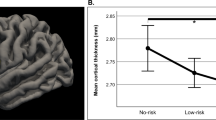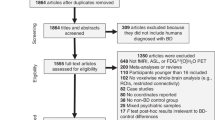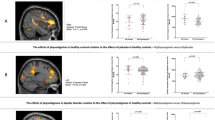Abstract
The symptoms of bipolar disorder suggest dysfunction of anterior limbic networks that modulate emotional behavior and that reciprocally interact with dorsal attentional systems. Bipolar patients maintain a constant vulnerability to mood episodes even during euthymia, when symptoms are minimal. Consequently, we predicted that, compared with healthy subjects, bipolar patients would exhibit abnormal activation of regions of the anterior limbic network with corresponding abnormal activation of other cortical areas involved in attentional processing. In all, 10 unmedicated euthymic bipolar patients and 10 group-matched healthy subjects were studied with fMRI while performing the Continuous Performance Task-Identical Pairs version (CPT-IP). fMRI scans were obtained on a 3.0 T Bruker system using an echo planar imaging (EPI) pulse sequence, while subjects performed the CPT-IP and a control condition to contrast group differences in regional brain activation. The euthymic bipolar and healthy subjects performed similarly on the CPT-IP, yet showed significantly different patterns of brain activation. Specifically, bipolar patients exhibited increased activation of limbic, paralimbic, and ventrolateral prefrontal areas, as well as visual associational cortices. Healthy subjects exhibited relatively increased activation in fusiform gyrus and medial prefrontal cortex. In conclusion, these differences suggest that bipolar patients exhibit overactivation of anterior limbic areas with corresponding abnormal activation in visual associational cortical areas, permitting successful performance of an attentional task. Since the differences occurred in euthymia, they may represent trait, rather than state, abnormalities of brain function in bipolar disorder.
Similar content being viewed by others
Log in or create a free account to read this content
Gain free access to this article, as well as selected content from this journal and more on nature.com
or
References
Adler CM, Holland SK, Enseleit S, Strakowski SM (2001b). Age-related changes in regional activation during working memory in young adults: an fMRI study. Synapse 42: 252–257.
Adler CM, Holland SK, Schmithorst V, Tuchfarber MJ, Strakowski SM (2004). Changes in neuronal activation in patients with bipolar disorder during performance of a working memory task. Bipolar Disord 6: 1–11.
Adler CM, McDonough-Ryan P, Sax KW, Holland SK, Arndt S, Strakowski SM (2000). Functional magnetic resonance imaging of neuronal activation with symptom provocation in unmedicated patients with obsessive–compulsive disorder. J Psychiatry Res 34: 317–324.
Adler CM, Sax KW, Holland SK, Schmithorst V, Rosenberg HL, Strakowski SM (2001a). Changes in neuronal activation with increasing attention demand in healthy volunteers: an fMRI study. Synapse 42: 266–272.
Bearden CE, Hoffman KM, Cannon TD (2001). The neuropsychology and neuroanatomy of bipolar affective disorder: a critical review. Bipolar Disord 3: 106–150.
Blumberg HP, Leung HC, Skudlarski P, Lacadie CM, Fredericks CA, Harris BC et al (2003). A functional magnetic resonance imaging study of bipolar disorder: state- and trait-related dysfunction in ventral prefrontal cortices. Arch Gen Psychiatry 60: 601–609.
Coren S, Ward LM (1989). Sensation and Perception. Harcourt Brace Jovanovich College Publishers: Orlando, FL. pp 27–28.
Cornblatt BA, Risch NJ, Faris G, Friedman D, Erlenmeyer-Kimling L (1988). The continuous performance test, identical pairs version (CPT-IP): I. New findings about sustained attention in normal families. Psychiatry Res 26: 223–238.
Crovitz HF, Zener K (1962). A group-test for assessing hand- and eye-dominance. Am J Psychol 75: 271–276.
First MB, Spitzer RL, Gibbon M, Williams JBW (1997). Clinical Interview for DSM-IV Axis I Disorders – Patient Edition (SCID-I/P). Biometrics Research Department New York State Psychiatric Institute: New York.
Häger F, Volz HP, Gaser C, Mentzel HJ, Kaiser WA, Sauer H (1998). Challenging the anterior attentional system with a continuous performance task: a functional magnetic resonance imaging approach. Eur Arch Psychiatry Clin Neurosci 248: 161–170.
Hamilton M (1960). A rating scale for depression. J Neurol Neurosurg Psychiatry 23: 56–62.
Holland S, Strawsburg RH, Weber AM, Dunn RS, Schmithorst V (1998b). fMRI of language distributions in pediatric epilepsy patients In: SNR XVI/ASNR. American Society of Neuroradiology: Philadelphia, PA.
Holland SK, Dunn R, Ball Jr W (1998a). Performing fMRI in the pediatric age group: technical and practical considerations In: 1st International Pediatric Neuroradiology Symposium. American Society of Neuroradiology: Philadelphia, PA.
Ketter TA, Kimbrell TA, George MS, Dunn RT, Speer AM, Benson BE et al (2001). Effects of mood and subtype on cerebral glucose metabolism in treatment-resistant bipolar disorder. Biol Psychiatry 49: 97–109.
Mayberg HS, Liotti M, Brannan SK, McGinnis S, Mahurin RK, Jerabek PA et al (1999). Reciprocal limbic-cortical function and negative mood: converging PET findings in depression and normal sadness. Am J Psychiatry 156: 675–682.
McClellan AT, Kushner H, Metzger D, Peters R, Smith I, Grissom G et al (1992). The fifth edition of the addiction severity index. J Sub Abuse Treat 9: 199–213.
Mega MS, Cummings JL, Salloway S, Malloy P (1997). The limbic system: an anatomic, phylogenetic, and clinical perspective. J Neuropsychiatr Clin Neurosci 9: 315–330.
Ongür D, Price JL (2000). The organization of networks within the orbital and medial prefrontal cortex of rats, monkeys, and humans. Cerebral Cortex 10: 206–219.
Phillips ML, Drevets WC, Rauch SL, Lane R (2003). Neurobiology of emotion perception II: implications for major psychiatric disorders. Biol Psychiatry 54: 515–528.
Strakowski SM (2002). Differential brain mechanisms in bipolar and unipolar disorders: considerations from brain imaging In: Soares JC (Ed). Brain Imaging in Affective Disorders. Marcel Dekker, Inc: New York.
Strakowski SM, Adler CM, DelBello MP (2002). Volumetric brain imaging in mood disorders. Bipolar Disord 4: 1–9.
Strakowski SM, DelBello MP, Fleck DE, Arndt S (2000c). The impact of substance abuse on the course of bipolar disorder. Biol Psychiatry 48: 477–485.
Strakowski SM, Williams JR, Fleck DE, DelBello MP (2000b). Eight-month functional outcome from mania following a first psychiatric hospitalization. J Psychiatr Res 34: 193–200.
Strakowski SM, Williams JR, Sax KW, Fleck DE, DelBello MP, Bourne ML (2000a). Is impaired outcome following a first manic episode due to mood-incongruent psychosis? J Aff Disord 61: 87–94.
Thévenaz P, Unser M (1998). A pyramid approach to sub-pixel registration based on intensity. IEEE Trans Image Process 7: 27–41.
Xiong J, Gao J-H, Lancaster JL, Fox PT (1995). Clustered pixels analysis for functional MRI activation studies of the human brain. Hum Brain Mapp 3: 287–301.
Yamasaki H, LaBar KS, McCarthy G (2002). Dissociable prefrontal brain systems for attention and emotion. Proc Natl Acad Sci USA 99: 11447–11451.
Young RC, Biggs JT, Ziegler VE, Meyer DA (1978). A rating scale for mania: reliability, validity and sensitivity. Br J Psychiatry 133: 429–435.
Acknowledgements
Supported by a grants from the Stanley Medical Research Institute and NIH Award MH58170 (SMS).
Author information
Authors and Affiliations
Corresponding author
Rights and permissions
About this article
Cite this article
Strakowski, S., Adler, C., Holland, S. et al. A Preliminary fMRI Study of Sustained Attention in Euthymic, Unmedicated Bipolar Disorder. Neuropsychopharmacol 29, 1734–1740 (2004). https://doi.org/10.1038/sj.npp.1300492
Received:
Revised:
Accepted:
Published:
Issue date:
DOI: https://doi.org/10.1038/sj.npp.1300492
Keywords
This article is cited by
-
Intrinsic functional connectivity correlates of cognitive deficits involving sustained attention and executive function in bipolar disorder
BMC Psychiatry (2023)
-
Analysis of Bipolar Disorder Using fMRI
Wireless Personal Communications (2023)
-
Aberrant Cerebello-Cerebral Connectivity in Remitted Bipolar Patients 1 and 2: New Insight into Understanding the Cerebellar Role in Mania and Hypomania
The Cerebellum (2022)
-
Differences in verbal and spatial working memory in patients with bipolar II and unipolar depression: an MSI study
BMC Psychiatry (2021)
-
Impaired sensory processing measured by functional MRI in Bipolar disorder manic and depressed mood states
Brain Imaging and Behavior (2018)



